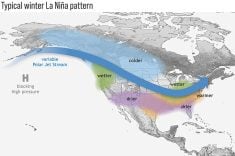The door to the lucrative wheat market south of the border has been slammed in the face of Canadian farmers.
Last week’s decision by the United States Department of Commerce to impose temporary anti-dumping duties of 8.15 percent on durum wheat and 6.12 percent on spring wheat has probably ended whatever slim chance the Canadian Wheat Board had of making sales to U.S. customers over the next few months.
“This should stop pre-bookings almost totally,” board chief executive officer Adrian Measner said following the May 2 anti-dumping ruling.
Read Also

Saskatchewan throne speech promises strong economy
Saskatchewan’s legislative agenda for the coming year will focus on meeting the challenges of new world trading relationships, said the speech from the throne.
When added to the 3.9 percent countervail duty on both commodities imposed by the department March 3, it means a U.S. buyer would have to pay duties of more than 12 percent on durum and 10 percent on spring wheat.
Based on current prices, that works out to a tax of $25 a tonne for durum and $15 a tonne for spring wheat.
Measner said the board will continue offering wheat and durum for sale to U.S. buyers and will remain in contact with its traditional customers south of the border.
But he acknowledged that there isn’t likely to be a lot of interest at those prices, other than perhaps some small shipments of specific quality.
“This won’t stop us from trying to sell to the U.S. … but these duties are very close to prohibitive,” he said.
Since the 3.9 percent countervail duty went into effect, the board has done a minimal amount of business with U.S. buyers. The financial penalty plus the uncertainty surrounding the anti-dumping case made those customers reluctant to make any forward commitments.
The wheat board says it extracts a premium of around 13 percent, or $31 a tonne, from the U.S. market, so it could conceivably swallow most of the duty and still get a better return from the U.S. than from other markets.
The U.S. National Millers’ Association criticized the imposition of the anti-dumping tariff, saying data presented to the commerce department show that wheat is traded fairly on the North American market.
In a News release
news, the association pointed to a report by the U.S. International Trade Commission last year that U.S. millers paid more for Canadian wheat than U.S. wheat in 59 of 60 months studied. That study was later extended and found that Canadian wheat was priced higher in 94 of 96 months.
Association officials say it will be up to individual millers and processors in the U.S. to try to negotiate favourable terms with the CWB and decide whether they can afford to pay the duties on Canadian wheat.
“In this business, where margins are razor-thin or non-existent, any duty causes us great concern,” said association vice-president James Bair.
He said millers can substitute winter wheat for spring wheat if necessary, but pasta manufacturers need high quality durum from Canada.
“People are going to have to consider every possible source of supply,” he said.
One saving grace is that the board didn’t have a lot of good quality wheat or durum available to sell to the U.S. because of last year’s drought-reduced and rain-damaged crop.
So far in 2002-03, the marketing agency has sold just 199,000 tonnes of durum and 157,000 tonnes of spring wheat to the U.S., and sales are now expected to end the year at around that level.
That’s far below the 1.1 million tonnes of wheat and 400,000 tonnes of durum that would be shipped south in a typical year.
But Measner said that while the short-term damage may be limited, the potential long-term damage is great.
“The U.S. is a valuable market and we believe Canada has the right to free, secure and unfettered access to that market.”
What is dumping?
The CWB was found guilty of selling wheat and durum
for less in Canada than in the U.S. in 2001-02.
That was based on the average price for the entire year and did not include sales of low grade wheat and durum in Canada or sales made at less than cost of production in Canada, as measured by a survey of 27 prairie farmers.














